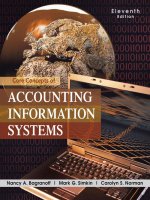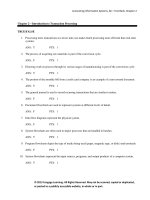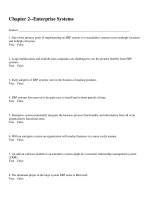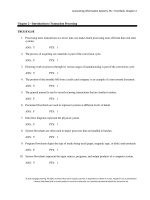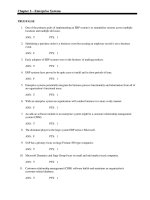Accounting information systems ch02
Bạn đang xem bản rút gọn của tài liệu. Xem và tải ngay bản đầy đủ của tài liệu tại đây (2.39 MB, 40 trang )
Enterprise
Systems
1
Learning Objectives
•
•
•
•
•
•
•
•
•
Describe enterprise systems
Describe enterprise resources
planning (ERP) systems
Explain the organization value chain
Describe relationship of
organization value chain and an
enterprise system
Illustrate value of systems
integration
Show how an enterprise’s system
provides support for an
organization’s processes
Summarize the major modules
contained in an ERP system
Describe how and enterprise system
supports major business event
processes
Enumerate the pros and cons of
implementing enterprise systems
Enterprise
Systems
Enterprise Systems on the AIS Wheel
• The enterprise
system cuts across
all accounting
application and
affects control
considerations
3
Enterprise System
• Integrates business processes and
information from entire enterprise
• Helps coordinate the operation of
business functions
• ERP systems are software packages
that can be used for the core systems
necessary to support enterprise
systems
4
ERP Systems Vendors
5
SAP
Modules
6
Third-Party Modules
• Customer Relationship Management
(CRM)—builds and maintains customer
related data
– Customer Self-Service (CSS)—allows
customers to complete tasks without
assistance
– Sales Force Automation (SFA)—automates
sales tasks such as order processing and
tracking
7
Third-Party Modules, Cont’d.
• Supply Chain Management (SCM)—
plans and executes demand planning,
inventory acquisition, manufacturing,
distributing and selling
• Product Lifecycle Management (PLM)—
manages product data from design
through disposal of product
8
Enterprise Systems Value Chain
• Enterprise systems facilitate value chain
management
• The value chain is the system of
activities that transform inputs into
outputs valued by the customer
• The goal of an organization is to add
the greatest value with the lowest costs
thereby increasing competitive
advantage
9
Value
Chain and
System
10
The Value of Systems Integration
• One of the values provided by an enterprise
system is the coordination of value activities
in the value chain.
• The system performs this coordination by
sharing data across business processes.
• In the following slides we describe what life
would be like without integrated systems and
then how enterprise systems solve some of
those problems.
11
Inefficient Customer Service
1. Check if the
customer exists
in the system
and has good
credit.
12
Inefficient Customer Service
2. Find out if
good can be
promised from
warehouse stock
or if it has to be
scheduled for
manufacturing.
Tell the
customer when
they would
receive
the item. The
date is known as
“available to
promise” or
ATP.
13
Inefficient Customer Service
3. If item is not
on the shelf, when
will it be released
from
manufacturing?
Sally could
review production
schedules and add
the time required
to pick, pack, and
ship the item.
This would not,
however, tell her
if the item
had already been
allocated to
another customer.
14
Inefficient Customer Service
4. In the event
that the item
must be
manufactured,
when could it be
scheduled, and
how long will
the
manufacturing
process take?
15
Inefficient Customer Service
5. How long will
it take vendors to
supply raw
materials so that
manufacturing
can take place?
16
Inefficient Customer Service
6. What price
will be charged
to this customer
for this order?
The price to
charge must be
obtained from
marketing.
17
Inefficient Customer Service
7. Needs to
check AR
balance to
determine if
customer has
sufficient credit.
Without direct
access to the
open AR data,
Sally will
have to call
accounting to
approve this
order.
18
Inefficient Customer Service
8. If credit is
insufficient,
must check with
credit
department for
change in credit
line.
19
Inefficient Customer Service
• Do you think that Sally wants to keep
the customer on the phone throughout
this process?
• Would you consider this to be good
customer service?
20
Solution to Inefficient Customer
Service
• Enterprise system establishes available
to promise (ATP) by checking
warehouses and scheduled
manufacturing
• Price and creditworthiness
automatically determined from database
21
Enterprise Systems Store Data in
Tables
22
Processing Orders Requires
Multiple Tables
23
Stored Data Used for Decisions
24
Major ERP Modules
• Sales and Distribution
– Records customer orders
– Shipping
– Billing
– Connections to
• Materials management module
• Financial accounting module
• Controlling module
• Based on SAP (best selling ERP)
25

